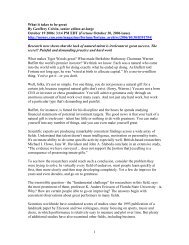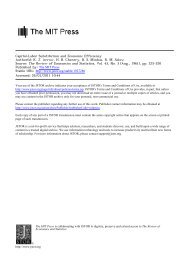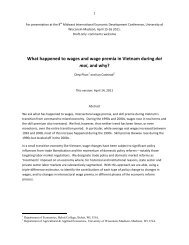Status of Wisconsin Agriculture 2010 - Agricultural & Applied ...
Status of Wisconsin Agriculture 2010 - Agricultural & Applied ...
Status of Wisconsin Agriculture 2010 - Agricultural & Applied ...
You also want an ePaper? Increase the reach of your titles
YUMPU automatically turns print PDFs into web optimized ePapers that Google loves.
ments and expand hiring until they<br />
are assured that consumer demand<br />
will be strong enough to buy additional<br />
products and services. This<br />
creates a chicken-and-egg problem,<br />
where consumers are reluctant to<br />
expand purchases until unemployment<br />
falls, and businesses are reluctant<br />
to invest and hire until<br />
consumer spending is strong enough<br />
to absorb the new capacity. This<br />
points to slow real GDP growth <strong>of</strong><br />
only about 2.0 to 2.5 percent in<br />
<strong>2010</strong>, as consumers and businesses<br />
feel their way forward.<br />
Many state governments face budget<br />
problems which will reduce the rate<br />
<strong>of</strong> growth <strong>of</strong> the overall U.S. economy.<br />
In a 2009 study, the Pew Center<br />
on the States examined in detail<br />
the problems <strong>of</strong> 11 states which face<br />
particularly difficult budget problems.<br />
The problems stemmed from<br />
widespread foreclosures, rising<br />
unemployment and poor financial<br />
management. California, other<br />
Western states and Florida—states<br />
which were hit hard by the bursting<br />
<strong>of</strong> the housing bubble—topped the<br />
list <strong>of</strong> states with budget problems.<br />
<strong>Wisconsin</strong>, Michigan and Illinois<br />
also made the Pew Center’s<br />
top-11 list.<br />
The Center on Budget and Policy<br />
Priorities forecasts that, barring<br />
more federal help, state budget cuts<br />
will shave nearly a percentage point<br />
<strong>of</strong>f growth in U.S. GDP and eliminate<br />
about 900,000 jobs in fiscal<br />
2011. These results would flow<br />
mainly from tax increases and<br />
budget cuts required to balance state<br />
budgets. Such an estimate should be<br />
viewed with caution, because it is<br />
unclear whether any organization<br />
can forecast such impacts on U.S.<br />
GDP with accuracy. But there is no<br />
question that the states’ budget problems<br />
are a strong headwind facing<br />
the U.S. economy.<br />
Government bailouts and loans were<br />
provided for large, financially-troubled<br />
banks and insurance companies<br />
and for General Motors (GM) and<br />
Chrysler—firms deemed too big to<br />
fail—with mixed results. Fortunately,<br />
many large banks returned to<br />
pr<strong>of</strong>itability late in 2009.<br />
As a result <strong>of</strong> its rescue efforts, the<br />
federal government acquired a 60<br />
percent stake in GM and a 10 percent<br />
stake in Chrysler. Both firms<br />
have emerged from bankruptcy, but<br />
Chrysler, in particular, remains in<br />
dire financial straits. Chrysler’s<br />
woes are reflected in its declining<br />
share <strong>of</strong> U.S. auto sales, which fell<br />
to 8.3 percent in September 2009,<br />
down from 11.1 percent a year earlier.<br />
Chrysler also suffers because it<br />
has few new models—especially<br />
fuel-efficient models—to <strong>of</strong>fer consumers.<br />
Fiat <strong>of</strong> Italy, which now<br />
owns 20 percent <strong>of</strong> Chrysler, will<br />
push to eliminate certain Chrysler<br />
and Jeep brands and introduce<br />
small, fuel-efficient cars and the<br />
premium Alfa Romeo brand in the<br />
United States as a partial replacement<br />
for discontinued Chrysler-<br />
Jeep products.<br />
Ford, which did not receive a government<br />
bailout, reported a $997<br />
million pr<strong>of</strong>it for the third quarter <strong>of</strong><br />
2009 and claims that it will return to<br />
solid pr<strong>of</strong>itability in 2011. This<br />
gives Ford a leg up on GM, which<br />
lost $1.15 billion in the third quarter<br />
<strong>of</strong> 2009. Ford’s third quarter <strong>of</strong> 2009<br />
pr<strong>of</strong>its reflect gains in market share,<br />
driven partly by sales <strong>of</strong> F-Series<br />
light trucks and Focus and Fusion<br />
cars. However, Ford too faces challenges.<br />
In particular, the company’s<br />
balance sheet showed $26.9 billion<br />
in debt at the end <strong>of</strong> the third quarter<br />
<strong>of</strong> 2009. This is probably manageable,<br />
but the company must sell into<br />
a U.S. car market that has shrunk<br />
from 16 million cars and light trucks<br />
in the early 2000s to a forecasted<br />
11.5 million units in <strong>2010</strong>.<br />
Problems remain for many regional<br />
banks, smaller banks and small businesses.<br />
Many bank failures occurred<br />
in Florida and California, where the<br />
burst <strong>of</strong> the housing bubble had big<br />
impacts. In addition, a large number<br />
<strong>of</strong> Georgia and Illinois banks failed<br />
in 2009. As <strong>of</strong> late November 2009,<br />
123 U.S. banks had failed, which is<br />
similar to the number <strong>of</strong> financial<br />
institutions that failed during the<br />
savings-and-loan crisis <strong>of</strong> the early<br />
1990s. Only one <strong>Wisconsin</strong> bank—<br />
the Bank <strong>of</strong> Elmwood in Racine—<br />
failed in 2009.<br />
Many banks fear problems with<br />
commercial real estate loans. In the<br />
third quarter <strong>of</strong> 2009, U.S. banks<br />
held $1.7 trillion <strong>of</strong> commercial<br />
mortgages and construction loans.<br />
Delinquencies on commercial mortgage<br />
debt played a role in the U.S.<br />
bank failures that occurred in 2009.<br />
While problems with commercial<br />
real estate will not rise to the level<br />
that emerged in residential real<br />
estate after 2007, the risk is potentially<br />
large for banks that hold large<br />
quantities <strong>of</strong> this debt.<br />
While many large businesses have<br />
gained access to additional credit in<br />
recent months, many small ones<br />
have not been so fortunate. This is<br />
partly because banks have tightened<br />
the underwriting standards for small<br />
business loans, making it difficult<br />
for many small businesses to qualify.<br />
One reason for the tighter lending<br />
standards is that banks still hold<br />
many bad loans that they do not<br />
wish to recognize as nonperforming.<br />
If all <strong>of</strong> these bad loans were pegged<br />
as nonperforming, a number <strong>of</strong> these<br />
banks could be forced into bankruptcy.<br />
The banks hope that they can<br />
renegotiate the loans in a manner<br />
that will allow the borrowers to<br />
make their payments. Cynics call<br />
this an “extend and pretend” lending<br />
strategy. While banks wait and see<br />
whether borrowers will resume<br />
making payments, they don’t want<br />
to take on additional small business<br />
loans that might go bad.<br />
Efforts by the Obama Administration<br />
to make TARP funds and Small<br />
Business Administration loans more<br />
readily available to small companies<br />
may help alleviate this problem.<br />
STATUS OF WISCONSIN AGRICULTURE <strong>2010</strong>—CURRENT OUTLOOK: GENERAL ECONOMY AND AGRICULTURAL TRADE 11







